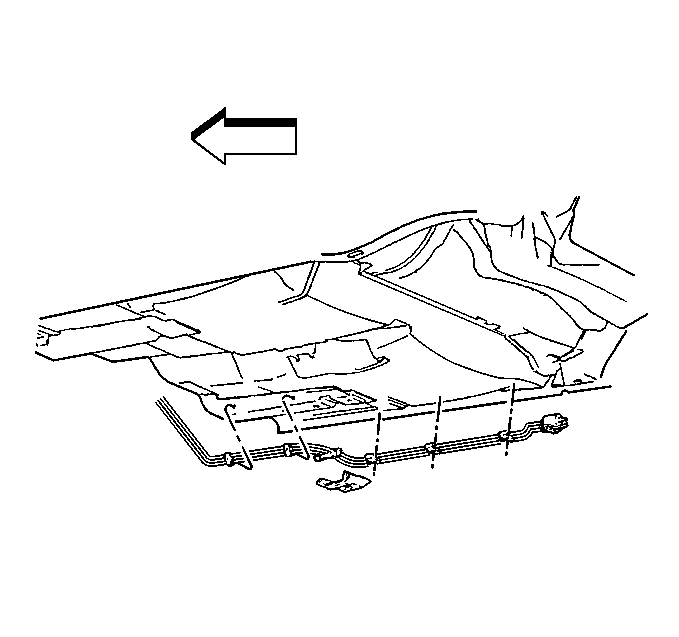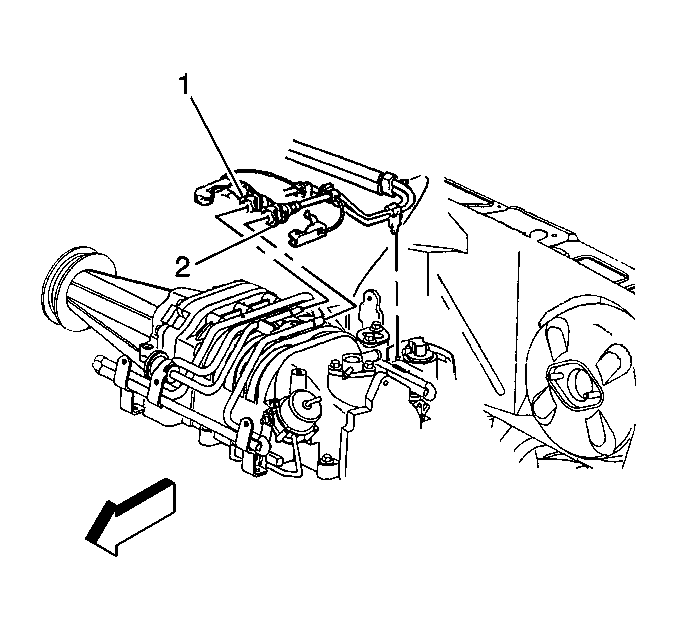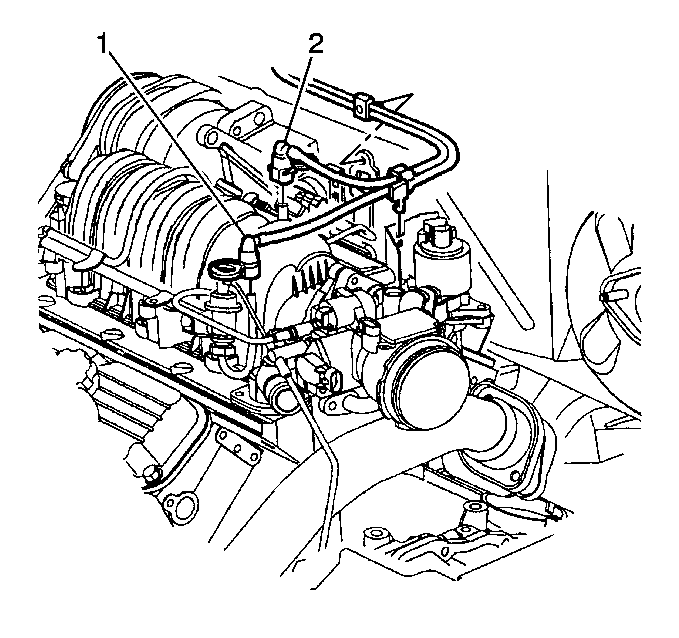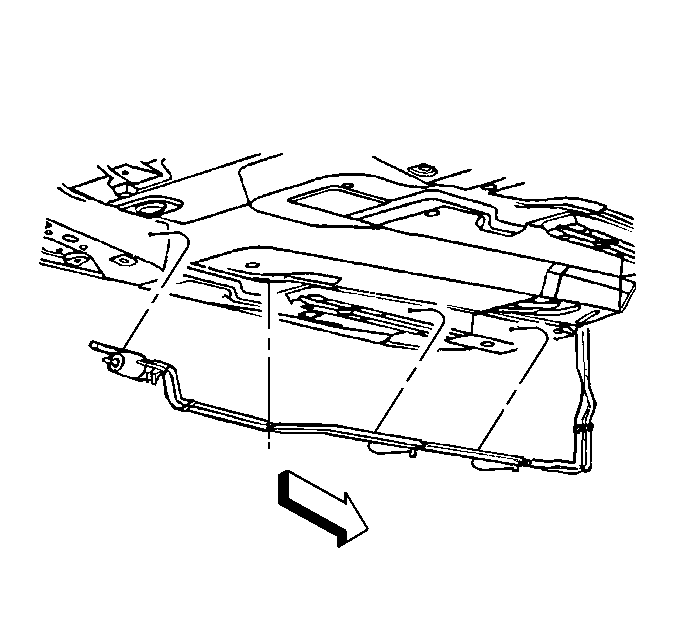Fuel Hose and Pipes Fuel Sender To Fuel Filter
Removal Procedure
Chassis Fuel Pipes - Fuel Sender Assembly to In-Pipe Fuel Filter

Caution: In order to Reduce the Risk of Fire and Personal Injury:
| • | If nylon fuel pipes are nicked, scratched or damaged during installation,
Do Not attempt to repair the sections of the nylon fuel pipes. Replace them. |
| • | When installing new fuel pipes, Do Not hammer directly on the
fuel harness body clips as it may damage the nylon pipes resulting in a possible
fuel leak. |
| • | Always cover nylon vapor pipes with a wet towel before using a
torch near them. Also, never expose the vehicle to temperatures higher than
115°C (239°F) for more than one hour, or more than 90°C (194°F)
for any extended period. |
| • | Before connecting fuel pipe fittings, always apply a few drops
of clean engine oil to the male pipe ends. This will ensure proper reconnection
and prevent a possible fuel leak. (During normal operation, the O-rings located
in the female connector will swell and may prevent proper reconnection if
not lubricated.) |
Notice: Do not attempt to straighten any kinked nylon fuel lines.
Replace any kinked nylon fuel feed or return pipes in order to prevent damage
to the vehicle.
- Relieve the fuel system fuel pressure. Refer to the
Fuel Pressure Relief
.
- Drain the fuel tank. Refer to
Fuel Tank Draining
.
- Remove the fuel tank. Refer to
Fuel Tank Replacement
.
- Remove the quick-connect fittings on the fuel sender assembly-side
of the in-pipe fuel. Refer to
Servicing Quick Connect Fittings
.
- Cap the fuel sender fuel pipes and the in-pipe fuel filter pipes
as needed to stop any fuel leakage.
- Remove the fuel feed, fuel return, and EVAP pipe attaching hardware
and the fuel feed, fuel return, and EVAP pipes.
- Check the position of the fuel and EVAP pipes and the fuel and
EVAP pipe attaching hardware for installation.
Installation Procedure

Caution: In order to Reduce the Risk of Fire and Personal Injury:
| • | If nylon fuel pipes are nicked, scratched or damaged during installation,
Do Not attempt to repair the sections of the nylon fuel pipes. Replace them. |
| • | When installing new fuel pipes, Do Not hammer directly on the
fuel harness body clips as it may damage the nylon pipes resulting in a possible
fuel leak. |
| • | Always cover nylon vapor pipes with a wet towel before using a
torch near them. Also, never expose the vehicle to temperatures higher than
115°C (239°F) for more than one hour, or more than 90°C (194°F)
for any extended period. |
| • | Before connecting fuel pipe fittings, always apply a few drops
of clean engine oil to the male pipe ends. This will ensure proper reconnection
and prevent a possible fuel leak. (During normal operation, the O-rings located
in the female connector will swell and may prevent proper reconnection if
not lubricated.) |
Notice: Do not attempt to straighten any kinked nylon fuel lines.
Replace any kinked nylon fuel feed or return pipes in order to prevent damage
to the vehicle.
- Install the new fuel feed, fuel return, and EVAP pipes and the fuel
and EVAP pipe attaching hardware as noted during removal.
- Install the caps from the in-pipe fuel filter pipes and the fuel
sender pipes.
- Install the new plastic retainers onto the in-pipe fuel filter
pipes and on the fuel sender pipes
- Install the quick-connect fittings. Refer to
Servicing Quick Connect Fittings
.
- Install the fuel tank. Refer to
Fuel Tank Replacement
.
- Add fuel to the tank.
- Install the fuel tank filler cap.
- Connect the negative battery cable.
| 8.1. | Turn the ignition switch ON for 2 seconds. |
| 8.2. | Turn the ignition switch OFF for 10 seconds. |
| 8.3. | Turn the ignition switch ON |
| 8.4. | Check for fuel leaks. |
Fuel Hose and Pipes Fuel Filter To Engine VIN 1
Chassis Fuel Pipes (VIN 1) - In-Pipe Fuel Filter to Engine Compartment
Removal Procedure
Tools Required
Refer to J 37088-A
,
Fuel Pipe Quick Connect Separator

- Relieve the fuel system fuel pressure. Refer to
Fuel Pressure Relief
.
- Clean all engine fuel pipe connections and areas surrounding the
engine fuel pipe connections before disconnecting the engine fuel pipe connections
to avoid possible contamination of the fuel system.
- Remove the fuel feed (2) and fuel return (1) quick-connect fittings
in the engine compartment. Refer to
Servicing Quick Connect Fittings
.
- Raise the vehicle.
- Remove the quick-connect fittings on the engine-side of the in-pipe
fuel filter. Refer to
Servicing Quick Connect Fittings
.
- Cap the in-pipe fuel filter pipe, the fuel feed pipe, and the
fuel return pipe as needed to stop any fuel leakage.
- Remove the fuel feed, fuel return, and EVAP pipe attaching hardware
and the fuel feed, fuel return, and EVAP pipes.
- Check the position of the fuel and EVAP pipes and the fuel and
EVAP pipe attaching hardware for installation.
- Inspect the pipes for bends, kinks, and cracks.
- Repair or replace the pipe or pipes as required.
Chassis Fuel Pipes (VIN 1) - In-Pipe Fuel Filter to Engine Compartment
Installation Procedure
Caution: In order to Reduce the Risk of Fire and Personal Injury: If nylon fuel
pipes are nicked, scratched or damaged during installation, they must be replaced.

- Install the new fuel feed, fuel return, and EVAP pipes and the
fuel and EVAP pipe attaching hardware as noted during removal.
- Remove the caps from the in-pipe fuel filter pipe, the fuel feed
pipe, and the fuel return pipe.
- Install new plastic connector retainers on the fuel pipes.
- Install the quick-connect fittings at the in-pipe fuel filter.
Refer to
Servicing Quick Connect Fittings
.
- Lower the vehicle.
- Install the quick-connect fittings in the engine compartment.
Refer to
Servicing Quick Connect Fittings
.
- Add fuel and install the fuel tank filler pipe cap.
- Tighten the fuel tank filler pipe cap.
- Install the negative battery cable.
| 9.1. | Turn the ignition switch to the On position for 2 seconds |
| 9.2. | Turn the ignition switch to the Off for 10 seconds. |
| 9.3. | Turn the ignition switch to the On position. |
| 9.4. | Check for fuel leaks. |
Fuel Hose and Pipes Fuel Filter To Engine VIN K
Chassis Fuel Pipes (VIN K) - In-Pipe Fuel Filter to Engine Compartment
Removal Procedure
Tools Required
Refer to J 37088-A
,
Fuel Pipe Quick Connect Separator

- Relieve the fuel system fuel pressure. Refer to
Fuel Pressure Relief
.
- Clean all engine fuel pipe connections and areas surrounding the
engine fuel pipe connections before disconnecting the engine fuel pipe connections
to avoid possible contamination of the fuel system.
- Remove the fuel feed (2) and fuel return (1) quick-connect fittings
in the engine compartment. Refer to
Servicing Quick Connect Fittings
.
- Raise the vehicle.
- Remove the quick-connect fittings on the engine-side of the in-pipe
fuel filter. Refer to
Servicing Quick Connect Fittings
.
- Cap the in-pipe fuel filter pipe, the fuel feed pipe, and the
fuel return pipe as needed to stop any fuel leakage.
- Remove the fuel feed, fuel return, and EVAP pipe attaching hardware
and the fuel feed, fuel return, and EVAP pipes.
- Check the position of the fuel and EVAP pipes and the fuel and
EVAP pipe attaching hardware for installation.
- Inspect the pipes for bends, kinks, and cracks.
- Repair or replace the pipe or pipes as required.
Chassis Fuel Pipe Replacement (VIN K) - In-Pipe Fuel Filter to Engine
Compartment
Installation Procedure

Caution: In order to Reduce the Risk of Fire and Personal Injury: If nylon fuel
pipes are nicked, scratched or damaged during installation, they must be replaced.
- Install the new fuel feed, fuel return, and EVAP pipes and the
fuel and EVAP pipe attaching hardware as noted during removal.
- Remove the caps from the in-pipe fuel filter pipe, the fuel feed
pipe, and the fuel return pipe.
- Install new plastic connector retainers on the fuel pipes.
- Install the quick-connect fittings at the in-pipe fuel filter.
Refer to
Servicing Quick Connect Fittings
.
- Lower the vehicle.
- Install the quick-connect fittings in the engine compartment.
Refer to
Servicing Quick Connect Fittings
.
- Add fuel and install the fuel tank filler pipe cap.
- Tighten the fuel tank filler pipe cap.
- Install the negative battery cable.
| 9.1. | Turn the ignition switch to the On position for 2 seconds |
| 9.2. | Turn the ignition switch to the Off for 10 seconds. |
| 9.3. | Turn the ignition switch to the On position. |
| 9.4. | Check for fuel leaks. |
Fuel Hose and Pipes EVAP Pipes
Removal Procedure

- Remove the hardware retaining the EVAP pipe.
- Inspect the location of the attaching hardware for installation.
- Remove the EVAP pipe.
- Inspect the pipe for bends, kinks, and cracks.
- Replace the pipes as required.
Installation Procedure

Notice: Properly secure the EVAP pipe in order to prevent chafing of the pipe.
Important: Route the replacement EVAP pipe in the same manner as the original EVAP
pipe was routed.
- Install the EVAP pipe.
- Install the hardware retaining the EVAP pipe.








